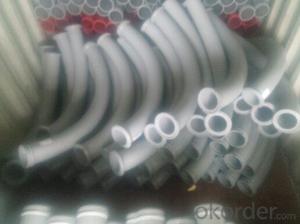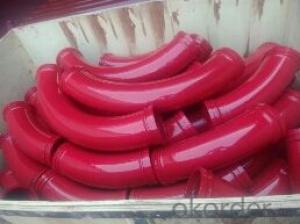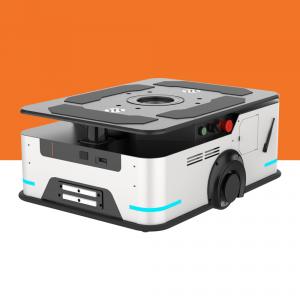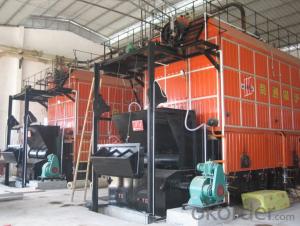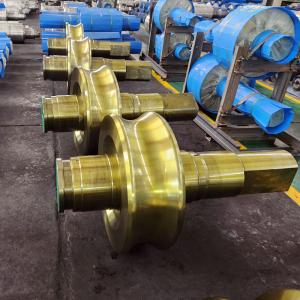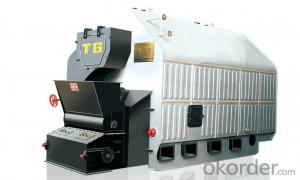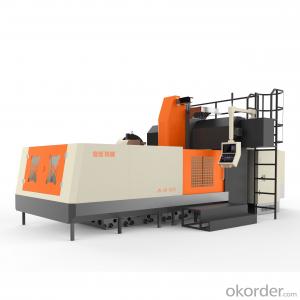Concrete Pump Truck Parts Bend ZX-HD DN125 R500 90DRG
- Loading Port:
- China main port
- Payment Terms:
- TT OR LC
- Min Order Qty:
- 100 pc
- Supply Capability:
- 10000 pc/month
OKorder Service Pledge
OKorder Financial Service
You Might Also Like
Product Description:
Widely used on concrete pump truck, concrete placing boom, trailer concrete pump etc, for concrete delivery pipe connection.
Our concrete pump pipes have been successfully exported to many countries from 1998, Our main markets as below: Middle East, Southeast Asia, America, Brazil, Italy, Russia, South Africa etc.
Main Product Features:
Adopt ST52 as standard material, which increases the concrete conveying life and reduces the frequency of replacement, saving the cost for the customers. Two production lines, wear-resistant pipe 100pcs daily, trailer pipe 400pcs daily.
Service life:7000-8000 CBM Concrete. Hydraulic tester & artificial detection.
Possess quality certification of ISO 9001:2000. Can pass CE test.
A wide range of specifications for you.
OEM service available.
Applications: Putzmeister, Schwing, Zoomlion, SANY, etc.
Product Specifications:
Inner diameter: 125mm(5.5")
Radius: 500mm
Degree: 90
Material: ST52
Characteristics: double-ends flange
Package: Seaworthy packing or as customers’ request.
FAQ:
Q1: How to confirm that your pipes could be used in our pump?
A1: We have been providing parts for nearly ten years, and cooperating with the agent of the world famous brand, possess near every kind of pipe in the market. What is more, we can produce as the customers’ request with drawing provided.
Q2: How do we guarantee the quality of our products?
A2: We have established an advanced quality management system which conducts strict quality tests at every step, from raw materials to the final product.
Q3: How soon can we receive the product after purchase?
A3: Within three days of placing an order, we will begin production. The specific shipping date is dependent upon international and government factors, but is typically 5-15 workdays.
Q4: If we can produce some Concrete Pump Truck Parts according to customers request?
A4: Yes, we can produce Concrete Pump Truck Parts according to the difference country situations to make it suitable to the market and customers. We have very professional technical team to make the design.
Q5: How to make a quick resolution for after service?
A5: OKorder and our manufacture both have overseas branches all-around of world, IF needed, the seller shall dispatch 2 engineers to the buyer's site for supervision of training. The buyer shall make available of necessary facilities & skilled personnel at site for training.
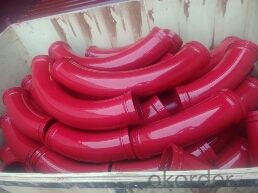
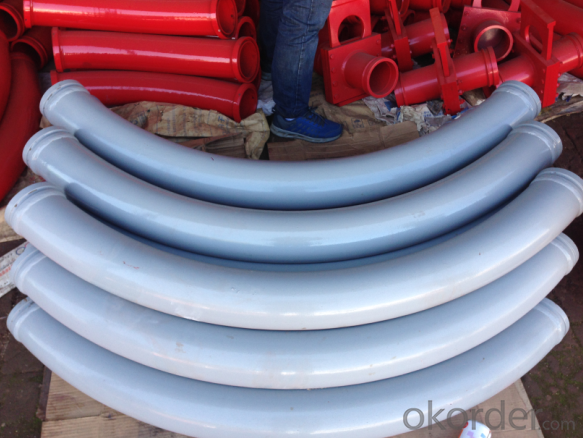
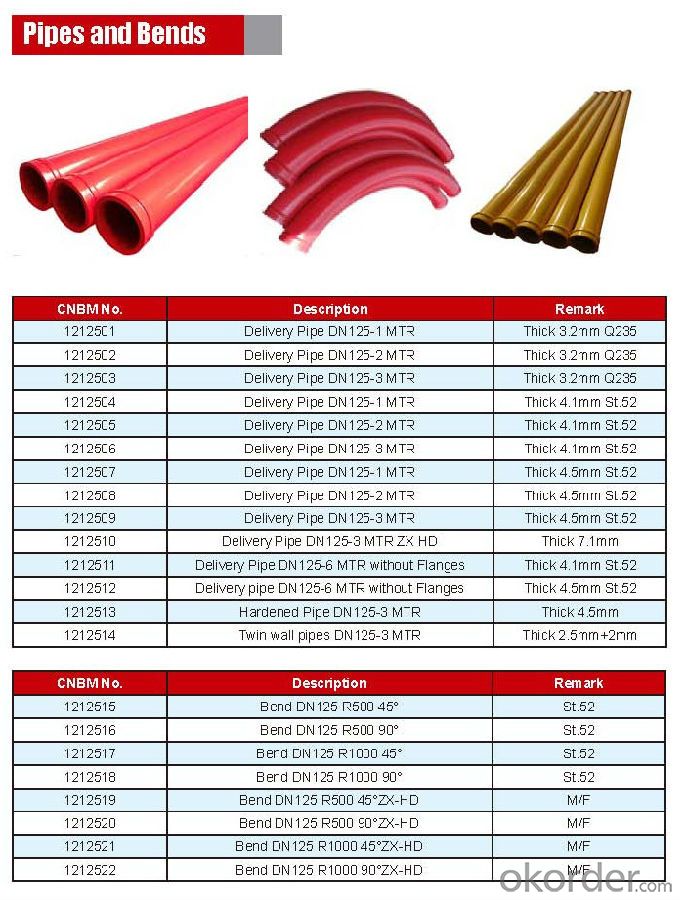


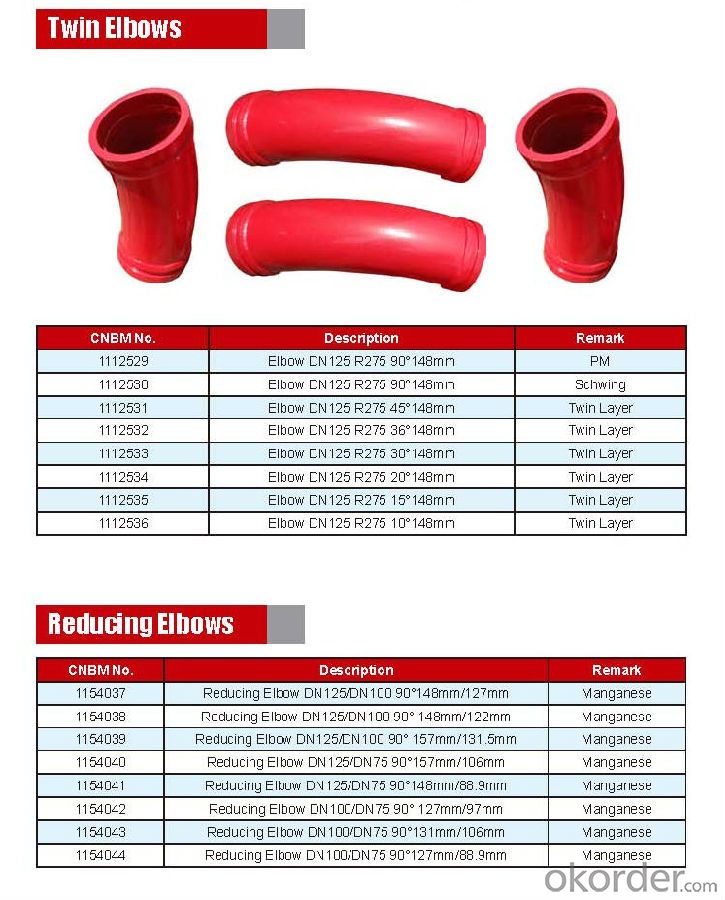

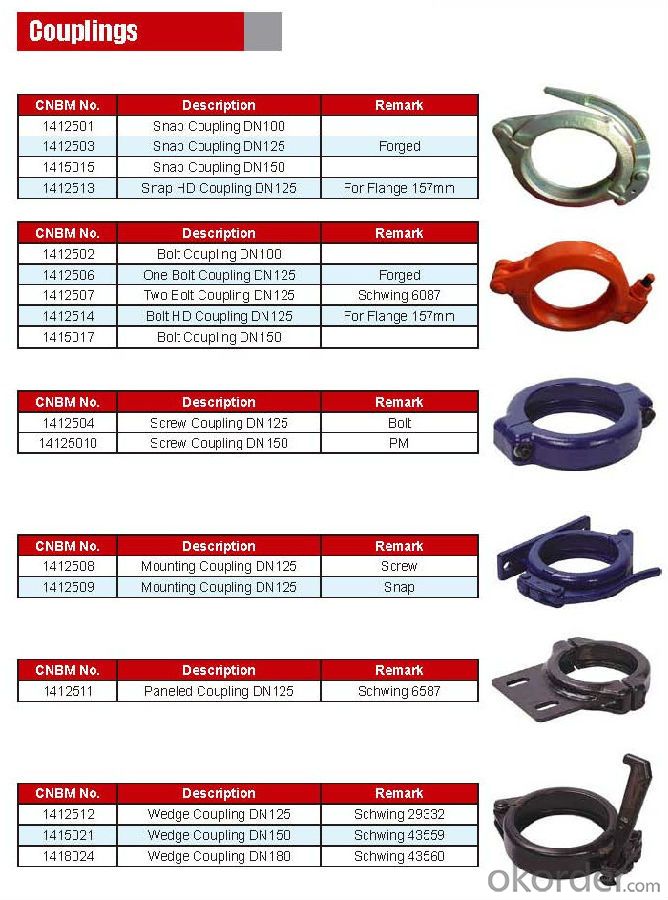
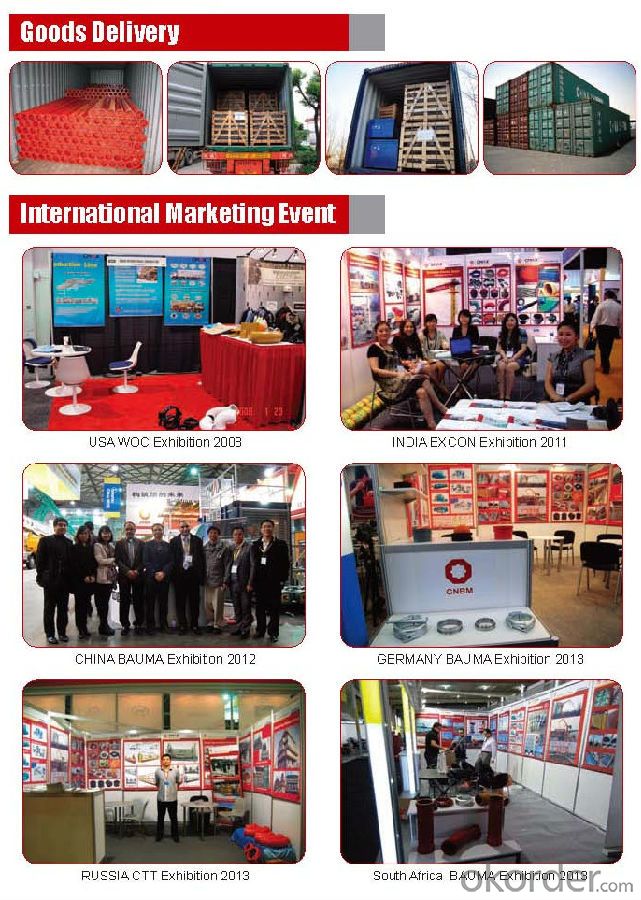
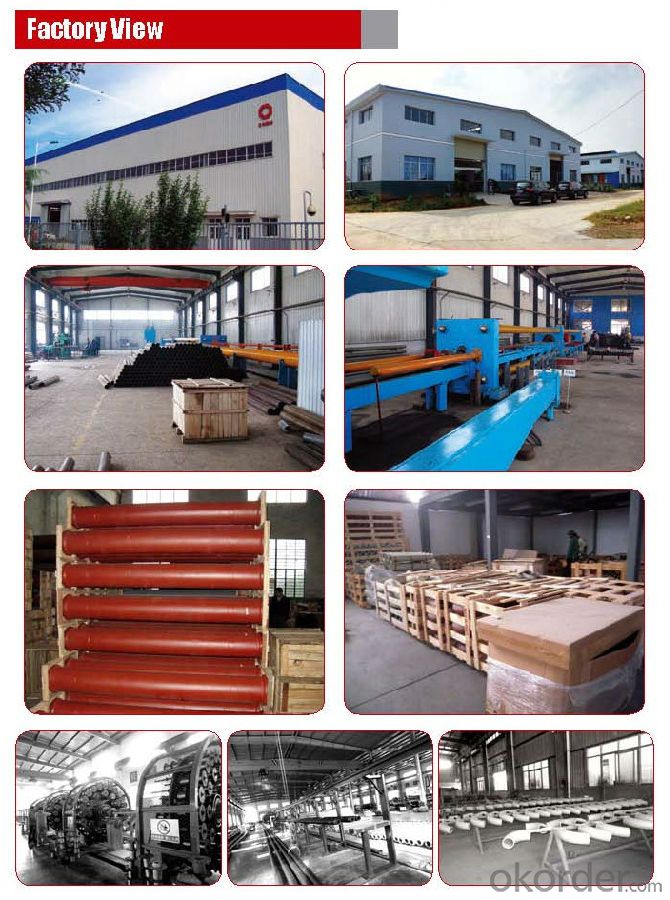
- Q:How often should concrete pump water pumps be inspected and replaced?
- The inspection and replacement frequency for concrete pump water pumps relies on multiple factors, including workload, operating conditions, and maintenance practices. It is generally advisable to inspect the water pump once a month to ensure proper functioning. During the inspection, it is crucial to check for leaks, unusual noises, and signs of wear and tear. If any issues are detected, immediate action should be taken, such as repairing or replacing damaged parts. Regarding replacement, it is challenging to provide an exact timeframe as it varies based on the pump's quality, intensity of use, and maintenance level. However, a general recommendation is to consider replacing the water pump every 1-2 years for heavy usage or every 3-5 years for moderate usage. Regular maintenance, including cleaning and lubricating the pump, can extend its lifespan and reduce the need for frequent replacements. It's important to note that these suggestions are general guidelines and may differ based on the manufacturer's instructions, industry standards, and local regulations. It is advisable to consult the manufacturer's guidelines and seek professional advice from experts in the field to determine the appropriate inspection and replacement schedule for concrete pump water pumps in your specific circumstances.
- Q:Can a concrete pump wear plate be repaired or does it need to be replaced entirely?
- In certain situations, a concrete pump wear plate may require repair or complete replacement. The determination of whether to repair or replace the wear plate depends on the extent of the damage and the overall condition of the plate. In the case of minor damages such as small cracks, dents, or worn out areas, suitable techniques can often be employed for repair. For instance, small cracks can be welded or filled with an appropriate epoxy or filler material. Similarly, dents or worn out areas can be filled and smoothed to restore the plate's functionality. However, if the wear plate has sustained significant damage, such as extensive cracks, severe corrosion, or large holes, it may be more advisable to replace the plate entirely. This is due to the potential compromise in the structural integrity and effectiveness of the wear plate if extensive damage is repaired. Optimal performance and safety of the concrete pump can be ensured by replacing the wear plate in these cases. Careful assessment of the wear plate's condition is crucial before deciding to repair or replace it. Seeking guidance from experts or professionals knowledgeable in concrete pump maintenance can provide valuable insights in making the appropriate decision. Additionally, regular maintenance and inspection of the wear plate can help detect potential issues early on, enabling timely repairs or replacements to prevent further damage and ensure the efficient operation of the concrete pump.
- Q:How often should concrete pump hydraulic oil coolers be inspected and maintained?
- Concrete pump hydraulic oil coolers should be inspected and maintained regularly to ensure optimal performance and prevent potential issues. The frequency of inspections and maintenance will depend on various factors such as the operating conditions, the workload of the pump, and the manufacturer's recommendations. As a general guideline, it is recommended to inspect and maintain concrete pump hydraulic oil coolers at least once every six months or every 500-700 operating hours, whichever comes first. However, in more demanding or extreme operating conditions, more frequent inspections and maintenance may be necessary. During these inspections, it is important to clean the cooler thoroughly and check for any signs of damage, corrosion, or leaks. Additionally, the oil cooler fins should be inspected for any blockages, as debris or dirt can reduce the cooler's effectiveness. Regularly checking and replacing the cooler's air filters is also crucial to maintain proper airflow and prevent overheating. Regular maintenance should include replacing the hydraulic oil and filters according to the manufacturer's recommendations. This helps to maintain the oil's viscosity and prevent any contaminants from damaging the cooler or other hydraulic components. In summary, it is essential to inspect and maintain concrete pump hydraulic oil coolers regularly to ensure efficient operation and prolong their lifespan. Following the manufacturer's guidelines and considering the specific operating conditions will help determine the appropriate frequency for inspections and maintenance.
- Q:How do concrete pump spare parts help in the pumping process?
- The smooth and efficient operation of a concrete pump relies heavily on spare parts. These parts are crucial for enhancing performance, extending the pump's lifespan, and ultimately saving costs. The use of concrete pump spare parts offers several advantages, one of which is improved pumping efficiency. These parts are meticulously manufactured to ensure the optimal flow of concrete through the pump. For example, the wear plate, wear ring, and S valve all play a crucial role in reducing friction and enhancing pumping performance. By minimizing friction and maintaining a consistent flow, these spare parts prevent blockages and allow for the smooth and efficient pumping of concrete. In addition, concrete pump spare parts are vital for minimizing downtime and reducing maintenance costs. Since the pump operates continuously, wear and tear are inevitable. However, replacing worn-out parts with high-quality spare parts on a regular basis can significantly prolong the pump's lifespan and decrease the need for frequent repairs. Investing in durable and reliable spare parts helps operators avoid unexpected breakdowns and costly repairs, ensuring uninterrupted and efficient pumping operations. Furthermore, concrete pump spare parts contribute to the safety of the pumping process. Components such as the safety valve, hopper grate, and control system all play critical roles in preventing accidents and ensuring the well-being of operators. These spare parts are designed to facilitate the safe and controlled pumping of concrete, reducing the risk of equipment failure and potential hazards. In conclusion, concrete pump spare parts are indispensable in the pumping process as they improve efficiency, minimize downtime and maintenance costs, and enhance safety. By investing in high-quality spare parts, operators can optimize the pump's performance, increase productivity, and achieve long-term cost savings.
- Q:Can concrete pump spare parts be painted or coated for increased durability?
- Yes, concrete pump spare parts can be painted or coated to increase their durability. The paint or coating acts as a protective layer, preventing corrosion and wear and tear, thus extending the lifespan of the spare parts.
- Q:What are the fittings of concrete pump?
- The commonly used electrical accessories (button switch, switch, trip circuit breaker, transformer terminals, etc.), hydraulic pipe
- Q:How can a faulty boom affect the concrete placement process?
- A faulty boom can significantly affect the concrete placement process. It can lead to uneven distribution of concrete, resulting in inconsistent concrete strength and quality. It may also cause the concrete to be placed in unintended areas or at incorrect heights, affecting the overall structural integrity of the project. Additionally, a faulty boom can pose a safety risk to workers and equipment involved in the concrete placement process.
- Q:How can a faulty concrete pump control valve affect the pumping operation?
- A faulty concrete pump control valve can have several negative effects on the pumping operation. Firstly, it can cause a loss of control over the concrete flow rate. The control valve is responsible for regulating the amount of concrete being pumped, and if it is faulty, it may not be able to properly adjust the flow rate. This can lead to either too much or too little concrete being pumped, which can result in an inefficient operation. Secondly, a faulty control valve can cause inconsistent concrete flow. The valve is designed to maintain a steady and consistent flow of concrete, but if it is not functioning properly, it may result in fluctuations in the flow. This can lead to uneven distribution of the concrete, which can affect the quality and integrity of the pumped concrete. Furthermore, a faulty control valve can also contribute to increased wear and tear on the pump and other components. When the valve is not operating correctly, it can cause excessive pressure or strain on the pump, leading to increased wear on the equipment. This can result in more frequent breakdowns or the need for repairs, which can be costly and time-consuming. Overall, a faulty concrete pump control valve can significantly impact the pumping operation by causing a loss of control over the flow rate, inconsistent concrete flow, and increased wear and tear on the equipment. It is important to regularly inspect and maintain the control valve to ensure its proper functioning and avoid these negative consequences.
- Q:How often should concrete pump hydraulic motors be inspected and replaced?
- Concrete pump hydraulic motors should be inspected regularly, ideally every 500 to 1000 hours of operation, to ensure they are in good working condition. However, the frequency of replacement depends on various factors such as usage intensity, maintenance practices, and the quality of the motor. Generally, hydraulic motors can last for several years if properly maintained, but if any signs of wear, leakage, or reduced performance are observed, it is recommended to replace them promptly to prevent potential breakdowns or accidents.
- Q:What is the function of a concrete pump hopper grate clamp?
- A concrete pump hopper grate clamp is a device used to secure the hopper grate in place on a concrete pump. The hopper grate is an essential component of the pump that acts as a filter to prevent large debris and foreign objects from entering the pump system. The clamp is designed to hold the hopper grate tightly in place, ensuring that it remains secure during the pumping process. By keeping the hopper grate in place, the clamp helps to maintain the integrity of the pump system and prevent any potential damage or blockages that could occur from the entry of unwanted materials. Overall, the function of a concrete pump hopper grate clamp is to provide a secure and reliable way to keep the hopper grate in place, allowing for smooth and efficient concrete pumping operations.
1. Manufacturer Overview |
|
|---|---|
| Location | |
| Year Established | |
| Annual Output Value | |
| Main Markets | |
| Company Certifications | |
2. Manufacturer Certificates |
|
|---|---|
| a) Certification Name | |
| Range | |
| Reference | |
| Validity Period | |
3. Manufacturer Capability |
|
|---|---|
| a)Trade Capacity | |
| Nearest Port | |
| Export Percentage | |
| No.of Employees in Trade Department | |
| Language Spoken: | |
| b)Factory Information | |
| Factory Size: | |
| No. of Production Lines | |
| Contract Manufacturing | |
| Product Price Range | |
Send your message to us
Concrete Pump Truck Parts Bend ZX-HD DN125 R500 90DRG
- Loading Port:
- China main port
- Payment Terms:
- TT OR LC
- Min Order Qty:
- 100 pc
- Supply Capability:
- 10000 pc/month
OKorder Service Pledge
OKorder Financial Service
Similar products
New products
Hot products
Related keywords
